Solar System: Things To Know This Week
Solar System: Things to Know This Week
Go for Venus! Fifty-five years ago this week, Mariner 2, the first fully successful mission to explore another planet launched from Cape Canaveral in Florida. Here are 10 things to know about Mariner 2.
1. Interplanetary Cruise

On August 27, 1962, Mariner 2 launched on a three and a half month journey to Venus. The little spacecraft flew within 22,000 miles (about 35,000 kilometers) of the planet.
2. Quick Study

Mariner 2’s scan of Venus lasted only 42 minutes. And, like most of our visits to new places, the mission rewrote the books on what we know about Earth’s sister planet.
3. Hot Planet

The spacecraft showed that surface temperature on Venus was hot enough to melt lead: at least 797 degrees Fahrenheit (425 degrees Celsius) on both the day and night sides.
4. Continuous Clouds
The clouds that make Venus shine so bright in Earth’s skies are dozens of miles thick and permanent. It’s always cloudy on Venus, and the thick clouds trap heat - contributing to a runaway “greenhouse effect.”
5. Night Light

Those clouds are why Venus shines so brightly in Earth’s night sky. The clouds reflect and scatter sunlight, making Venus second only to our Moon in celestial brightness.
6. Under Pressure
Venus’ clouds also create crushing pressure. Mariner 2’s scan revealed pressure on the surface of Venus is equal to pressure thousands of feet under Earth’s deepest oceans.
7. Slow Turn
Mariner 2 found Venus rotates very slowly, and in the opposite direction of most planets in our solar system.
8. Space Travel Is Tough
Mariner 2 was a remarkable accomplishment, considering that in 1962 engineers were still in the very early stages of figuring out how operate spacecraft beyond Earth orbit. The first five interplanetary missions launched - by the U.S. and Soviet Union, the only two spacefaring nations at the time - were unsuccessful.
9. Not Ready for Its Close Up
Mariner 2 carried no cameras. The first close-up pictures of Venus came from NASA’s Mariner 10 in 1974.
10. Hot Shot

The first (and still incredibly rare) photo of the surface of Venus was taken by the Soviet Venera 9 lander, which survived for a little more than a minute under the crushing pressure and intense heat on the ground.
Make sure to follow us on Tumblr for your regular dose of space: http://nasa.tumblr.com
More Posts from Venusearthpassage and Others
Meet Our New Flight Directors!
We just hired six new flight directors to join a unique group of individuals who lead human spaceflights from mission control at our Johnson Space Center in Houston.

A flight director manages all human spaceflight missions and related test flights, including International Space Station missions, integration of new American-made commercial spacecraft and developing plans for future Orion missions to the Moon and beyond.
Only 97 people have served as flight directors, or are in training to do so, in the 50-plus years of human spaceflight. That’s fewer than the over 300 astronauts! We talked with the new class about their upcoming transitions, how to keep calm in stressful situations, the importance of human spaceflight and how to best learn from past mistakes. Here’s what they had to say…
Allison Bollinger

Allison is from Lancaster, Ohio and received a BS in Aerospace Engineering from Purdue University. She wanted to work at NASA for as long as she can remember. “I was four-and-a-half when Challenger happened,” she said. “It was my first childhood memory.” Something in her clicked that day. “After, when people asked what I wanted to be when I grew up, I said an astronaut.”
By high school a slight fear of heights, a propensity for motion sickness and an aptitude for engineering shifted her goal a bit. She didn’t want to be an astronaut. “I wanted to train astronauts,” she said. Allison has most recently worked at our Neutral Buoyancy Lab managing the daily operations of the 40-ft-deep pool the astronauts use for spacewalk training! She admits she’ll miss “the smell of chlorine each day. Coming to work at one of the world’s largest pools and training astronauts is an incredible job,” she says. But she’s excited to be back in mission control, where in a previous role she guided astronauts through spacewalks.
She’s had to make some tough calls over the years. So we asked her if she had any tips for when something… isn’t going as planned. She said, “It’s so easy to think the sky is falling. Take a second to take a deep breath, and then you’ll realize it’s not as bad as you thought.”
Adi Boulos

Adi is from Chicago, Illinois and graduated from the University of Illinois Urbana Champaign with a BS in Aerospace Engineering. He joined us in 2008 as a member of the very first group of flight controllers that specialize in data handling and communications and tracking systems aboard the space station.
Most recently he served as the group lead in the Avionics Trainee group, which he loved. “I was managing newer folks just coming to NASA from college and getting to become flight controllers,” he said. “I will miss getting to mentor them from day one.” But he’s excited to start his new role alongside some familiar faces already in mission control. “It’s a great group of people,” he said of his fellow 2018 flight director class. “The six of us, we mesh well together, and we are all from very diverse backgrounds.”
As someone who has spent most of his career supporting human spaceflight and cargo missions from mission control, we asked him why human spaceflight is so important. He had a practical take. “It allows us to solve problems we didn’t know we had,” he said. “For example, when we went to the moon, we had to solve all kinds of problems on how to keep humans alive for long-duration flights in space which directly impacts how we live on the ground. All of the new technology we develop for living in space, we also use on the ground.”
Marcos Flores

Marcos is from Caguas, Puerto Rico and earned a BS in Mechanical Engineering from the University of Puerto Rico and an MS in Aerospace Engineering from Purdue University. Spanish is his first language; English is his second.
The first time he came to the Continental US was on a trip to the Kennedy Space Center in Florida as a kid! “I always knew I wanted to work for NASA,” he said. “And I knew I wanted to be an engineer because I liked to break things to try to figure out how they worked.” He joined us in 2010 as an intern in a robotics laboratory working on conceptual designs for an experimental, autonomous land rover. He later transitioned to the space station flight control team, where he has led various projects, including major software transitions, spacewalks and commercial cargo missions!
He shares his new coworkers’ thoughts on the practical aspects of human spaceflight and believes it’s an expression of our “drive to explore” and our “innate need to know the world and the universe better.” But for him, “It’s more about answering the fundamental questions of where we come from and where we’re headed.”
Pooja Jesrani

Pooja graduated from The University of Texas at Austin with a BS in Aerospace Engineering. She began at NASA in 2007 as a flight controller responsible for the motion control system of the International Space Station. She currently works as a Capsule Communicator, talking with the astronauts on the space station, and on integration with the Boeing Starliner commercial crew spacecraft.
She has a two-year-old daughter, and she’s passionate about motherhood, art, fashion, baking, international travel and, of course, her timing as a new flight director! “Not only have we been doing International Space Station operations continuously, and we will continue to do that, but we are about to launch U.S. crewed vehicles off of U.S. soil for the first time since the space shuttle in 2011. Exploration is ramping up and taking us back to the moon!” she said.” “By the time we get certified, a lot of the things we will get to do will be next-gen.”
We asked her if she had any advice for aspiring flight directors who might want to support such missions down the road. “Work hard every day,” she said. “Every day is an interview. And get a mentor. Or multiple mentors. Having mentorship while you progress through your career is very important, and they really help guide you in the right direction.”
Paul Konyha
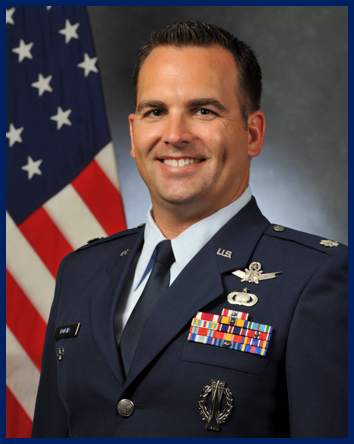
Paul was born in Manhasset, NY, and has a BS in Mechanical Engineering from Louisiana Tech University, a Master’s of Military Operational Arts and Science from Air University, and an MS in Astronautical Engineering from the University of Southern California. He began his career as an officer in the United States Air Force in 1996 and authored the Air Force’s certification guide detailing the process through which new industry launch vehicles (including SpaceX’s Falcon 9) gain approval to launch Department of Defense (DoD) payloads.
As a self-described “Star Wars kid,” he has always loved space and, of course, NASA! After retiring as a Lieutenant Colonel in 2016, Paul joined Johnson Space Center as the Deputy Director of the DoD Space Test Program Human Spaceflight Payloads Office. He’s had a rich career in some pretty high-stakes roles. We asked him for advice on handling stress and recovering from life’s occasional setbacks. “For me, it’s about taking a deep breath, focusing on the data and trying not to what if too much,” he said. “Realize that mistakes are going to happen. Be mentally prepared to know that at some point it’s going to happen—you’re going to have to do that self-reflection to understand what you could’ve done better and how you’ll fix it in the future. That constant process of evaluation and self-reflection will help you get through it.”
Rebecca Wingfield

Rebecca is from Princeton, Kentucky and has a BS in Mechanical Engineering from the University of Kentucky and an MS in Systems Engineering from the University of Houston, Clear Lake. She joined us in 2007 as a flight controller responsible for maintenance, repairs and hardware installations aboard the space station.
Since then, she’s worked as a capsule communicator for the space station and commercial crew programs and on training astronauts. She’s dedicated her career to human spaceflight and has a special appreciation for the program’s long-term benefits. “As our human race advances and we change our planet in lots of different ways, we may eventually need to get off of it,” she said. “There’s no way to do that until we explore a way to do it safely and effectively for mass numbers of people. And to do that, you have to start with one person.” We asked her if there are any misconceptions about flight directors. She responded, “While they are often steely-eyed missile men and women, and they can be rough around the edges, they are also very good mentors and teachers. They’re very much engaged in bringing up the next generation of flight controllers for NASA.”

Congrats to these folks on leading the future of human spaceflight!
You can learn more about each of them HERE.
Make sure to follow us on Tumblr for your regular dose of space: http://nasa.tumblr.com
Ten Interesting facts about Mercury
Mercury is the closest planet to the sun. As such, it circles the sun faster than all the other planets, which is why Romans named it after their swift-footed messenger god. He is the god of financial gain, commerce, eloquence, messages, communication (including divination), travelers, boundaries, luck, trickery and thieves; he also serves as the guide of souls to the underworld

Like Venus, Mercury orbits the Sun within Earth’s orbit as an inferior planet, and never exceeds 28° away from the Sun. When viewed from Earth, this proximity to the Sun means the planet can only be seen near the western or eastern horizon during the early evening or early morning. At this time it may appear as a bright star-like object, but is often far more difficult to observe than Venus. The planet telescopically displays the complete range of phases, similar to Venus and the Moon, as it moves in its inner orbit relative to Earth, which reoccurs over the so-called synodic period approximately every 116 days.

Mercury’s axis has the smallest tilt of any of the Solar System’s planets (about 1⁄30 degree). Its orbital eccentricity is the largest of all known planets in the Solar System; at perihelion, Mercury’s distance from the Sun is only about two-thirds (or 66%) of its distance at aphelion.

Its orbital period around the Sun of 87.97 days is the shortest of all the planets in the Solar System. A sidereal day (the period of rotation) lasts about 58.7 Earth days.

Mercury’s surface appears heavily cratered and is similar in appearance to the Moon’s, indicating that it has been geologically inactive for billions of years. Having almost no atmosphere to retain heat, it has surface temperatures that vary diurnally more than on any other planet in the Solar System, ranging from 100 K (−173 °C; −280 °F) at night to 700 K (427 °C; 800 °F) during the day across the equatorial regions. The polar regions are constantly below 180 K (−93 °C; −136 °F). The planet has no known natural satellites.

Unlike many other planets which “self-heal” through natural geological processes, the surface of Mercury is covered in craters. These are caused by numerous encounters with asteroids and comets. Most Mercurian craters are named after famous writers and artists. Any crater larger than 250 kilometres in diameter is referred to as a Basin.

The largest known crater is Caloris Basin, with a diameter of 1,550 km. The impact that created the Caloris Basin was so powerful that it caused lava eruptions and left a concentric ring over 2 km tall surrounding the impact crater.
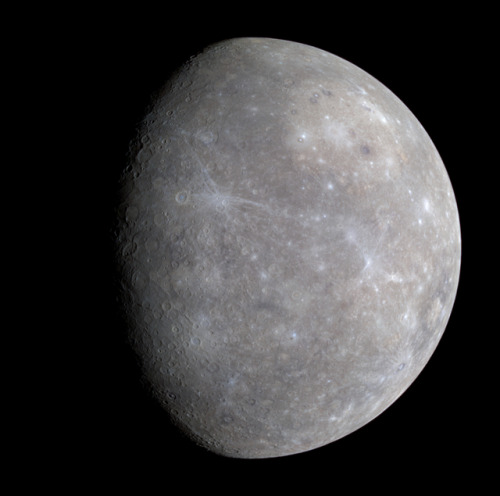
Two spacecraft have visited Mercury: Mariner 10 flew by in 1974 and 1975; and MESSENGER, launched in 2004, orbited Mercury over 4,000 times in four years before exhausting its fuel and crashing into the planet’s surface on April 30, 2015.

It is the smallest planet in the Solar System, with an equatorial radius of 2,439.7 kilometres (1,516.0 mi). Mercury is also smaller—albeit more massive—than the largestnatural satellites in the Solar System, Ganymede and Titan.

As if Mercury isn’t small enough, it not only shrank in its past but is continuing to shrink today. The tiny planet is made up of a single continental plate over a cooling iron core. As the core cools, it solidifies, reducing the planet’s volume and causing it to shrink. The process crumpled the surface, creating lobe-shaped scarps or cliffs, some hundreds of miles long and soaring up to a mile high, as well as Mercury’s “Great Valley,” which at about 620 miles long, 250 miles wide and 2 miles deep (1,000 by 400 by 3.2 km) is larger than Arizona’s famous Grand Canyon and deeper than the Great Rift Valley in East Africa.

The first telescopic observations of Mercury were made by Galileo in the early 17th century. Although he observed phases when he looked at Venus, his telescope was not powerful enough to see the phases of Mercury.
source 1
source 2
source 3
images: Joseph Brimacombe, NASA/JPL, Wikimedia Commons
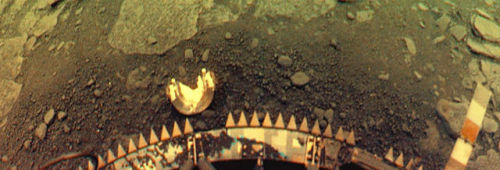
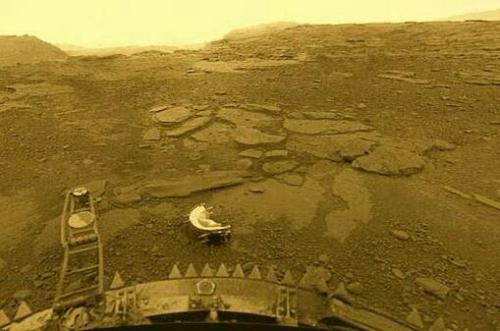
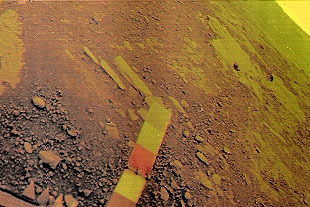
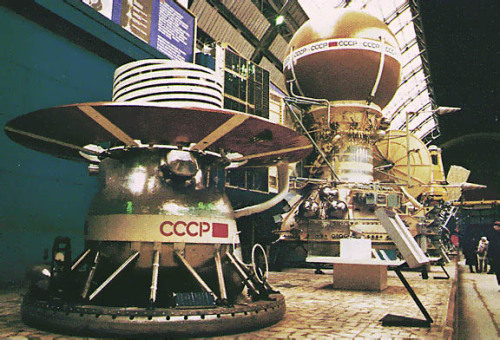
Venera
The Venera series space probes were developed by the Soviet Union between 1961 and 1984 to gather data from Venus, Venera being the Russian name for Venus. As with some of the Soviet Union’s other planetary probes, the later versions were launched in pairs with a second vehicle being launched soon after the first of the pair.
Ten probes from the Venera series successfully landed on Venus and transmitted data from the surface of Venus, including the two Vega program and Venera-Halley probes. In addition, thirteen Venera probes successfully transmitted data from the atmosphere of Venus.
Among the other results, probes of the series became the first human-made devices to enter the atmosphere of another planet (Venera 4 on October 18, 1967), to make a soft landing on another planet (Venera 7 on December 15, 1970), to return images from the planetary surface (Venera 9 on June 8, 1975), and to perform high-resolution radar mapping studies of Venus (Venera 15 on June 2, 1983). The later probes in the Venera series successfully carried out their mission, providing the first direct observations of the surface of Venus. Since the surface conditions on Venus are extreme, the probes only survived on the surface for durations varying between 23 minutes (initial probes) up to.
source


Transit of Venus in 2012
Credit: NASA / SDO

Please Build A Cloud City Over Venus

TODAY IN HISTORY: Planet Venus, observed by NASA’s Pioneer 12 space probe on February 26, 1979.

A Sun Pillar over Norway via NASA https://ift.tt/2Hnj1WZ

Computer Simulated Global View of Venus.
📷 NASA/Jet Propulsion Laboratory-Caltech
Ten interesting facts about Uranus
Like the classical planets, Uranus is visible to the naked eye, but it was never recognised as a planet by ancient observers because of its dimness and slow orbit. Sir William Herschel announced its discovery on 13 March 1781, expanding the known boundaries of the Solar System for the first time in history and making Uranus the first planet discovered with a telescope.

1° Uranus is the seventh planet from the Sun. It has the third-largest planetary radius and fourth-largest planetary mass in the Solar System. Uranus is similar in composition to Neptune, and both have different bulk chemical composition from that of the larger gas giants Jupiter and Saturn.

2° Like all of the giant planets, Uranus has its share of moons. At present, astronomers have confirmed the existence of 27 natural satellites. But for the most part, these moons are small and irregular.

3° Uranus’ moons are named after characters created by William Shakespeare and Alexander Pope. These include Oberon, Titania and Miranda. All are frozen worlds with dark surfaces. Some are ice and rock mixtures. The most interesting Uranian moon is Miranda; it has ice canyons, terraces, and other strange-looking surface areas.

4° Only one spacecraft in the history of spaceflight has ever made a close approach to Uranus. NASA’s Voyager 2 conducted its closest approach to Uranus on January 24th, 1986, passing within 81,000 km of the cloud tops of Uranus. It took thousands of photographs of the gas/ice giant and its moons before speeding off towards its next target: Neptune.

5° Uranus has rings: All the gas and ice giants have their own ring systems, and Uranus’ is the second most dramatic set of rings in the Solar System.
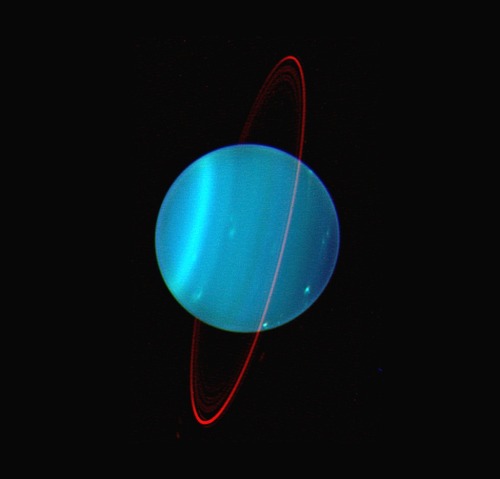
6° Uranus makes one trip around the Sun every 84 Earth years. During some parts of its orbit one or the other of its poles point directly at the Sun and get about 42 years of direct sunlight. The rest of the time they are in darkness.

7° All of the planets in the Solar System rotate on their axis, with a tilt that’s similar to the Sun. In many cases, planet’s have an axial tilt, where one of their poles will be inclined slightly towards the Sun. But the axial tilt of Uranus is a staggering 98 degrees! In other words, the planet is rotating on its side.

8° Uranus is approximately 4 times the sizes of Earth and 63 times its volume.

9° Uranus is blue-green in color, the result of methane in its mostly hydrogen-helium atmosphere. The planet is often dubbed an ice giant, since 80 percent or more of its mass is made up of a fluid mix of water, methane, and ammonia ices.

10° Uranus hits the coldest temperatures of any planet. With minimum atmospheric temperature of -224°C Uranus is nearly coldest planet in the solar system. While Neptune doesn’t get as cold as Uranus it is on average colder. The upper atmosphere of Uranus is covered by a methane haze which hides the storms that take place in the cloud decks.
source 1, source 2, source 2
Images credit: NASA
-
 complicaitlin liked this · 4 years ago
complicaitlin liked this · 4 years ago -
 climate-changing liked this · 6 years ago
climate-changing liked this · 6 years ago -
 sensoryo reblogged this · 6 years ago
sensoryo reblogged this · 6 years ago -
 marizeoliver liked this · 6 years ago
marizeoliver liked this · 6 years ago -
 dewptldor-blog liked this · 7 years ago
dewptldor-blog liked this · 7 years ago -
 venusearthpassage reblogged this · 7 years ago
venusearthpassage reblogged this · 7 years ago -
 catyuy reblogged this · 7 years ago
catyuy reblogged this · 7 years ago -
 venusearthpassage reblogged this · 7 years ago
venusearthpassage reblogged this · 7 years ago -
 kelicalypso reblogged this · 7 years ago
kelicalypso reblogged this · 7 years ago -
 fleurdebach5-blog liked this · 7 years ago
fleurdebach5-blog liked this · 7 years ago -
 gennady40 reblogged this · 7 years ago
gennady40 reblogged this · 7 years ago -
 gennady40 liked this · 7 years ago
gennady40 liked this · 7 years ago -
 maya-rin reblogged this · 7 years ago
maya-rin reblogged this · 7 years ago -
 maya-rin liked this · 7 years ago
maya-rin liked this · 7 years ago -
 luadocalypso liked this · 7 years ago
luadocalypso liked this · 7 years ago -
 draess-art liked this · 7 years ago
draess-art liked this · 7 years ago -
 trigrerhiden liked this · 7 years ago
trigrerhiden liked this · 7 years ago -
 motherwhatswrongwme liked this · 7 years ago
motherwhatswrongwme liked this · 7 years ago -
 jennifornow reblogged this · 7 years ago
jennifornow reblogged this · 7 years ago -
 net-bolezniamru liked this · 7 years ago
net-bolezniamru liked this · 7 years ago -
 alxanicole liked this · 7 years ago
alxanicole liked this · 7 years ago -
 alazebyar liked this · 7 years ago
alazebyar liked this · 7 years ago -
 afrodita-niculescu-blog liked this · 7 years ago
afrodita-niculescu-blog liked this · 7 years ago -
 inkyshark reblogged this · 7 years ago
inkyshark reblogged this · 7 years ago -
 spacerascal1 reblogged this · 7 years ago
spacerascal1 reblogged this · 7 years ago -
 quantumsuperposition1111 liked this · 7 years ago
quantumsuperposition1111 liked this · 7 years ago -
 ozzypozzy liked this · 7 years ago
ozzypozzy liked this · 7 years ago -
 tysavestheworld reblogged this · 7 years ago
tysavestheworld reblogged this · 7 years ago